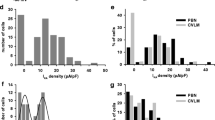Abstract
Squid olfactory receptor neurons are primary bipolar sensory neurons capable of transducing water-born odorant signals into electrical impulses that are transmitted to the brain. In this study, we have identified and characterized the macroscopic properties of voltage-gated Na+ channels in olfactory receptor neurons from the squid Lolliguncula brevis. Using whole-cell voltage-clamp techniques, we found that the voltage-gated Na+ channels were tetrodotoxin sensitive and had current densities ranging from 5 to 169 pA pF−1. Analyses of the voltage dependence and kinetics revealed interesting differences from voltage-gated Na+ channels in olfactory receptor neurons from other species; the voltage of half-inactivation was shifted to the right and the voltage of half-activation was shifted to the left such that a “window-current” occurred, where 10–18% of the Na+ channels activated and did not inactivate at potentials near action potential threshold. Our findings suggest that in squid olfactory neurons, a subset of voltage-gated Na+ channels may play a role in generating a pacemaker-type current for setting the tonic levels of electrical activity required for transmission of hyperpolarizing odor responses to the brain.
Similar content being viewed by others
Author information
Authors and Affiliations
Additional information
Accepted: 1 October 1998
Rights and permissions
About this article
Cite this article
Chen, N., Lucero, M. Transient and persistent tetrodotoxin-sensitive sodium currents in squid olfactory receptor neurons. J Comp Physiol A 184, 63–72 (1999). https://doi.org/10.1007/s003590050306
Issue Date:
DOI: https://doi.org/10.1007/s003590050306



